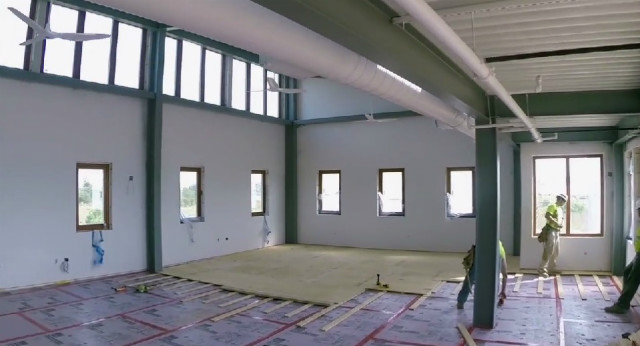All green building standards – whether LEED, Green Globes, or Living Building Challenge – either encourage or even require percentages of recycled material. You might find this element met in the building itself, or in fixtures and furnishings, but in almost every case, you going to see “new” products mades for recycled material (like the Icestone countertops in my parents’ bathrooms… which is gorgeous). Nothing wrong with that, but what about all the sinks, door knobs, doors, molding, and other materials torn out of older homes for renovations, or left over from new construction? An awful lot of that material will end up in the landfill: about 160 million tons per year, according to the EPA.
So, why not just use that stuff in new green buildings? That’s exactly what the Chesapeake Bay Foundation is doing in the construction of its Brock Environmental Center building in Virginia Beach, Virginia. The Foundation is aiming for LEED Platinum status, as well as Living Building Challenge certification, and according to the Foundation’s Hampton Roads Director Christy Everett, they’ve been dumpster diving for the past year and a half to collect usable materials for the new buildings. In her Huffington Post overview, Everett lists the following salvaged materials:
- used sinks, doors, mirrors, counters, and cabinets from office buildings about to be remodeled or torn down were salvaged and will find new life in the Brock Center;
- old wooden school bleachers were saved and used as trim for the new center’s doors and windows;
- maple flooring in the gymnasium of a former elementary school was removed, reinstalled, and resurfaced as new flooring in the center;
- used bike racks came from a local parks department;
- hundreds of champagne corks were collected for use as knobs and drawer-pulls in the center;
- student art tables will be used as counter tops;
- and old wooden paneling will be made into cabinets.
While I suspect that, in many of these cases, the “dumpster diving” involved more reaching out to contractors rather than rooting through the trash, that really doesn’t matter: CBF thought outside the box to not only meet the standards for which they’re aiming, but probably also saved some money on materials. And that’s good for the Chesapeake Bay…
Get a full overview of the Brock Environmental Center, scheduled to open this Fall, in the video below, and let us know about other building projects involving materials saved from landfills.
August Drone Video from Hourigan Construction on Vimeo.
Featured image credit: Screen capture from “August Drone Video”

